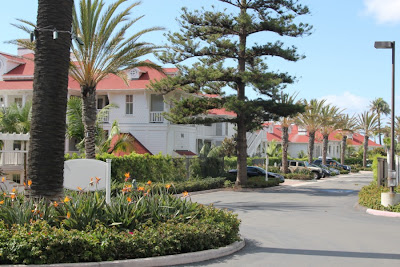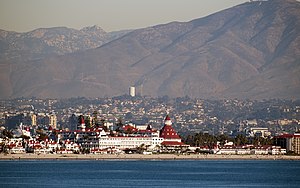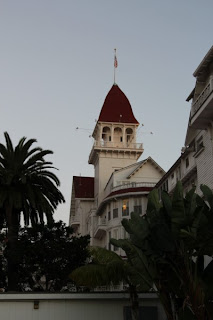These are the hotel apt's/condo's a very wealthy person can rent, rather than a dowdy room.
Beach view of the condo's...


This is a 'hotel guests only' outside dining area..
This is an open Bar and Grill..even the hill people are permitted to sit here....so we did...had some salads and a beer, just to play the part.
Hotel del Coronado
From Wikipedia, the free encyclopedia
| Hotel del Coronado | |
|---|---|
 |
|
| Location | United States |
| Address | 1500 Orange Avenue Coronado, California |
| Coordinates | 32.6809°N 117.1784°WCoordinates: 32.6809°N 117.1784°W |
| Opening date | 1887 |
| Architect | Reid & Reid |
| Management | KSL Resorts |
| Rooms | 680 |
| Suites | Junior Suites Victorian Suites Signature Suite Resort Suites Beach Village cottages Beach Village villas |
| Restaurants | 1500 Ocean Sheerwater Babcock & Story Bar ENO |
| Floors | 7 |
| Website | www.hoteldel.com |
Hotel del Coronado
|
|
| Architectural style: | Late Victorian, Queen Anne |
| Governing body: | Private |
| NRHP Reference#: | 71000181 |
| CHISL #: | 844 |
| Significant dates | |
| Added to NRHP: | October 14, 1971 |
| Designated NHL: | May 5, 1977 |
| Designated CHISL: | 1970 |
| References: [1][2][3][4] | |
When it opened in 1888, it was the largest resort hotel in the world. It has hosted presidents, royalty, and celebrities through the years.[6] The hotel has been featured in numerous movies and books.
The hotel received a Four Diamond rating from the American Automobile Association,[7] and was once listed by USA Today as one of the "Top 10 Resorts In The World", though it has since been removed from that list. [8]
Contents |
History
San Diego land boom
In the mid-1880s, the San Diego region was in the midst of one of its first real estate booms. At that time, it was common for a developer to build a grand hotel as a draw for what would otherwise be a barren landscape. The Hollywood Hotel in Hollywood, California, the Raymond Hotel in Pasadena, the Del Monte in Monterey, and the Hotel Redondo in Redondo Beach California were similar grand hotels built as development enticements during this era. [9]Coronado Beach Company
On December 19, 1880, three people went together to buy all of Coronado and North Island for $110,000. Those people were E. S. Babcock, retired railroad executive from Evansville, Indiana, Hampton L. Story, of the Story and Clark Piano Company of Chicago, and Jacob Gruendike, president of the First National Bank of San Diego.The men hired architect James W. Reid, a native of New Brunswick, Canada, who first practiced in Evansville and Terre Haute. His younger brother Merritt Reid, a partner in Reid Brothers, the Evansville firm, stayed in Indiana, but brother Watson Reid helped supervise the 2,000 laborers needed.[9]
Babcock's visions for the hotel were grand:
"It would be built around a court...a garden of tropical trees, shrubs and flowers,.... From the south end, the foyer should open to Glorietta Bay with verandas for rest and promenade. On the ocean corner, there should be a pavilion tower, and northward along the ocean, a colonnade, terraced in grass to the beach. The dining wing should project at an angle from the southeast corner of the court and be almost detached, to give full value to the view of the ocean, bay and city."[10]
Construction
Construction of the hotel began in March, 1887, "on a sandspit populated by jack rabbits and coyotes".[11] If the hotel were ever to be built, one of numerous problems to overcome was the absence of lumber and labor in the San Diego area. The lumber problem was solved with contracts for exclusive rights to all raw lumber production of the Dolbeer & Carson Lumber Company of Eureka, California, which was one of the West's largest. Planing mills were built on site to finish raw lumber shipped directly from the Dolbeer & Carson lumber yards, located on the shores of Humboldt Bay.[9]To obtain brick and concrete, Reid built his own kilns. He also constructed a metal shop and iron works. [12]Labor was provided largely by Chinese immigrants from San Francisco and Oakland.[9]
The Crown Room was Reid's masterpiece. Its wooden ceiling was installed with pegs and glue. Not a single nail was used.[13]
Dealing with fire hazards
Reid's plans were being revised and added to constantly. To deal with fire hazards, a freshwater pipeline was run under San Diego Bay. Water tanks and gravity flow sprinklers were installed. He also built two giant cisterns with concrete walls a foot thick in the basement to store rainwater. Although these cisterns were never used for rainwater, they were reputedly very handy for storing alcoholic beverages during Prohibition. Reid also installed the world's first oil furnace in the new hotel, prompting a Los Angeles oil company to build tankers to carry the oil to Coronado.[14] Electric lighting in a hotel was also a world first. The electric wires were installed inside the gas lines, so if the "new-fangled" electricity didn't work, they could always pipe gas in to illuminate the rooms.[9] Thomas Edison inspected the final electrical installation, and returned in 1904 to oversee the nation's first illuminated outdoor Christmas tree,[citation needed] which was placed on the hotel's lawn.Grand opening and real estate bust
When the hotel opened for business in February 1888,[15] 1,440 San Diegans traveled across the bay. Reports of the new grand hotel were wired across the county, but just as the hotel was nearing completion, the Southern California land boom collapsed. Babcock and Story needed additional funds at a time when many people were deserting San Diego. Babcock turned to Captain Charles T. Hinde and sugar magnate John D. Spreckels, who loaned them $100,000 to finish the hotel. The Coronado Beach Company was then capitalized with three million United States dollars. The company directors at this time were E.S. Babcock, John Diedrich Spreckels, Captain Charles T. Hinde, H.W. Mallett, and Giles Kellogg.[16] By 1890 Spreckels bought out both Babcock and Story. The Spreckels family retained ownership of the hotel until 1948.[9]The original grounds had many amenities, including an Olympic-sized salt water pool, tennis courts, and a yacht club with architecture resembling the hotel's grand tower. A Japanese tea garden, an ostrich farm, billiards, bowling alleys, hunting expeditions, and deep sea fishing were some of the many features offered to its guests.[9]
Prince Edward and Wallis Simpson
On April 7, 1920 Edward, Prince of Wales, was honored with a grand banquet in the Crown Room. There has been speculation that it was at this event that he first met his future wife Wallis Spencer, later known as Wallis Simpson, who lived in Coronado at the time.[13] However, most historians believe they did not meet at that time,[17] and both Edward and Wallis wrote in their memoirs that they met much later.[18]Hollywood's playground
The popularity of the hotel was established before the 1920s. It already had hosted Presidents Harrison, McKinley, Taft, and Wilson.[19] By the 1920s Hollywood's stars and starlets discovered that 'the Del' was the 'in place' to stay. Many celebrities made their way south to party during the era of Prohibition and used the Hotel Del as their personal playground. Tom Mix, Rudolph Valentino, Charlie Chaplin, and Ramón Novarro were a few of the many actors who stayed at the hotel during weekend getaways.[20]On New Year's Day 1937, during the Great Depression, the gambling ship SS Monte Carlo, known for "drinks, dice, and dolls", was shipwrecked on the beach about a quarter mile south of the Hotel del Coronado.[21]
World War II, middle age, and rebirth
During World War II, many West Coast resorts and hotels were taken over by the U.S. government for use as housing and hospitals. The Hotel del Coronado housed many pilots, who were being trained at nearby North Island Naval Air Station on a contract basis, but it was never commandeered. General manager Steven Royce convinced the Navy to abstain from taking over the hotel, because most of the additional rooms were being used to house the families of officers. He pointed out that "the fathers, mothers and wives were given priority to the rooms because it may be the last time they will see their sons and husbands." Ultimately the Navy agreed, and the hotel never was appropriated.[22]The hotel was designated as a "wartime casualty station". It began a victory garden program, planting vegetables on all spare grounds around the hotel.[23]
Barney Goodman purchased the hotel from the Spreckels in 1948.[24] From the end of World War II until 1960, the hotel began to age. While still outwardly beautiful, neglect was evident. In 1960, local millionaire John Alessio purchased the hotel and spent $2 million on refurbishment and redecorating.[25] Alessio sold the hotel to M. Larry Lawrence in 1963.
Lawrence's initial plan was to develop the land around the hotel and ultimately, to demolish it.[26] Lawrence later changed his mind. During his tenure, Lawrence invested $150 million to refurbish and expand much of the hotel. He doubled its capacity to 700 rooms. He added the Grande Hall Convention Center and two seven-story Ocean Towers just south of the hotel. The Lawrence family sold the hotel to the Travelers Group after his death in 1996.[27] The Travelers Group completed a $55 million upgrade of the hotel in 2001, which included seismic retrofitting.[28]
The Hotel today
In 2003, Travelers sold the property to CNL Hospitality Properties Inc. and KSL Recreation Corp (CNL/KSL). This ownership group completed a $10 million upgrade of 381 rooms in June, 2005. The hotel is currently owned by the Blackstone Group LP (60%), Strategic Hotels & Resorts Inc. (34.5%), and KSL Resorts (5.5%). When Strategic Hotels & Resorts Inc. bought its stake in 2006, the hotel was valued at $745 million; currently, the hotel is valued at roughly $590 million.[29]
-
Dragon Tree located at the Hotel del Coronado
Notable guests
Notable guests have included Thomas Edison, L. Frank Baum, Charlie Chaplin, Vincent Price, Babe Ruth, Veronica Covance, and Reggie White.The following presidents have stayed at the hotel: Benjamin Harrison, William McKinley, William Howard Taft, Woodrow Wilson, Franklin D. Roosevelt, Dwight D. Eisenhower, John F. Kennedy, Lyndon B. Johnson, Richard Nixon, Gerald Ford, Jimmy Carter, Ronald Reagan, George H. W. Bush, Bill Clinton, George W. Bush, and Barack Obama.[19]
Another famous resident of the hotel is the purported ghost of Kate Morgan. On November 24, 1892, she checked into room 304 (then 3318, now 3327), to meet her husband, who was a doctor. He was going to give her medicine for her stomach cancer, but he never arrived. She was found dead on the steps leading to the beach three days later. The case was declared a suicide; she had shot herself. Since then, some guests that have checked into room 3327, have reported flickering lights and floating objects.[30]
In fiction and film
L. Frank Baum, author of The Wonderful Wizard of Oz, did much of his writing at the hotel, and is said to have based his design for the Emerald City on it.[31] However, other sources say the Emerald City was inspired by the "White City" of the Chicago World's Fair of 1893.[32][33] Ambrose Bierce used the hotel as the setting for his short story, An Heiress From Redhorse.[citation needed] It also was the setting for the 1975 novel Bid Time Return by Richard Matheson; however, for the movie version, Somewhere in Time, the story setting and filming were moved to the Grand Hotel (Mackinac Island) on Mackinac Island, Michigan.[citation needed]The initial story inspiration for the movie and short story 1408 came from a collection of real-life news stories about parapsychologist Christopher Chacon's investigation of a notoriously haunted room at the hotel. The short story was written by Stephen King.[citation needed]
The hotel was first featured in a film in 1927, when it was used as a backdrop for the film The Flying Fleet. Since then, it has been featured in at least twelve other films, including: Some Like It Hot (which starred Marilyn Monroe, Jack Lemmon, and Tony Curtis where it was called the "Seminole Ritz"), The Stunt Man (which starred Peter O'Toole), Wicked, Wicked (which was completely filmed on location there), and the 1990 version of My Blue Heaven (which starred Steve Martin and Rick Moranis).[34]
In the 14th and 15th episodes of the 4th season of Baywatch, called Coronado del Soul Part 1 and 2, the story evolves in and around the Hotel.
The hotel is featured on a US Postage Stamp honoring director Billy Wilder, with images of Marilyn Monroe and the hotel from Some Like It Hot. [35]
After our pretend to stay here stroll, we just wandered the streets and we found it such a nice experience. Quiet..laid back. Really pleasant to just wander about.
I usually gravitate to water..and so we ended up back on the water, close to the Coronado Yacht Club.

Walking south...what have we here but the Coronado Boat House...that opens at 5 for Happy Hour...
And we snuck in while their backs were turned....had some appies and a couple drinkie poos.
Had a whole herb steamed artichoke......
N some coconut/panco crusted shrimps
And...with our perfect timing, ended up back in front of the del (that is the local reference..the del) as the sun dropped.
And we ended the day in a fine fashion.
















































No comments:
Post a Comment